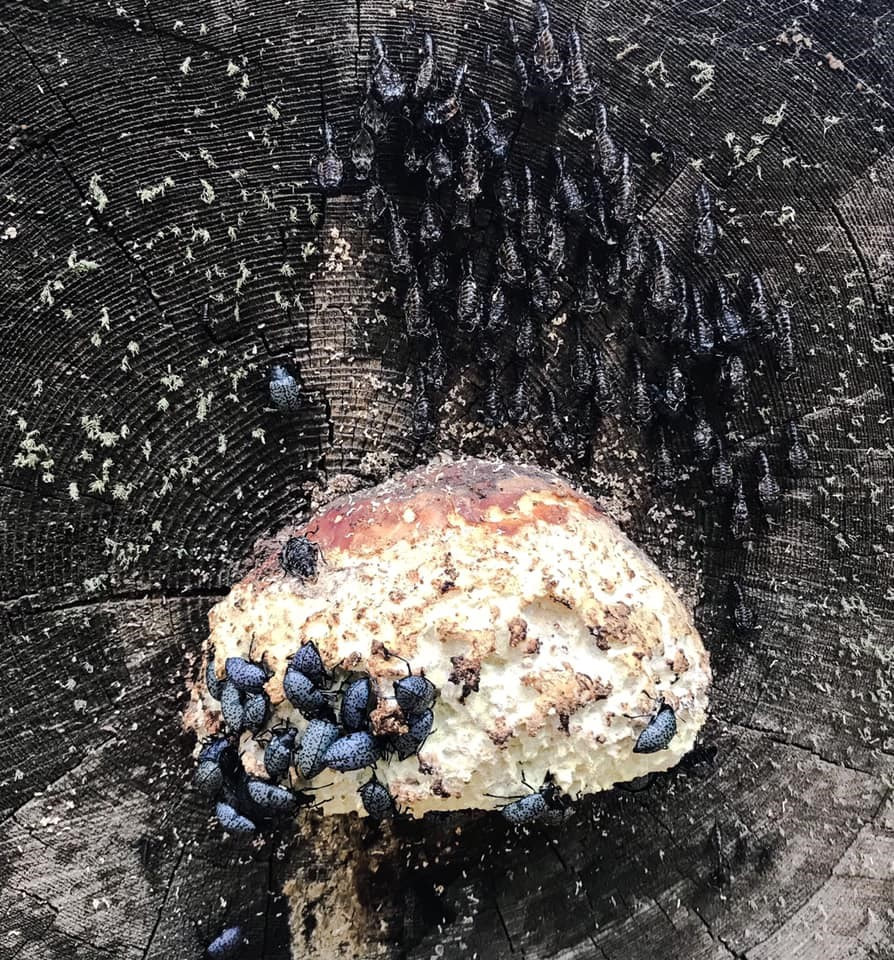|
The moment I saw Iren’s picture I was hooked and had to look these beetles up. I am always trying to figure out who is feasting on the multitude of deadly amanitas that live all around me in Maine and sure enough the Pleasing Fungus Beetle lives in Maine too, and its larvae feed on amanitas. It’s hard to tell from the picture but I suspect that Iren’s fungus might be an amanita too.
Obviously, whoever named this beetle was an enthusiastic entomologist, that is, a person who studies insects! Pleasing fungus beetles are worldwide in distribution, but the vast majority of the species occur in the tropics. Of the approximately 3,500 known species, only 51 are found in America north of Mexico. The name ‘fungus beetle’ may be applied to several closely-related groups of beetles. The most commonly encountered ‘fungus beetles’ are the ‘Silken Fungus Beetles’ and the ‘Minute Brown Scavenger Beetles’. As its common name implies, Fungus Beetles feed on a wide variety of fungi not just amanitas. Fungus beetles also feed on mold or mildews and are attracted to anything that is musty smelling. Moisture levels in new buildings will often attract these insects. Fungus Beetles are harmless, but small enough to get through most screening, vents and other openings. They can be found flying around in homes during late summer. Some Fungus Beetles are small red/orange and black and these are the ones I am familiar with. Some beetles are splashed with iridescent bright blue or green, although they too have a primarily black shell. Others are simply brown or black. The ones in the picture have a bluish caste to them. Fungus beetles measure from one tenth to one sixth of an inch in length. Some Fungus beetles have clubbed antennae. Others have bodies covered with dimple – like punctures. Fungus beetles develop from egg larva pupa to adult according to temperature. They can mature in 25 –to 36 days at 75 degrees, but at lower temperatures adults may take 5 months to mature. A wide variety of the fruiting bodies of fungi serves as hosts for the family as a whole, but each pleasing fungus beetle species seems to be specific to a certain group of fungi. The species with larger individuals, feed in the harder bracket fungi found on dead trees and stumps. Others feed on oyster mushrooms or feed on other mushrooms growing from dead logs and roots. Some members feed on fungi that have mycorrhyzal associations with living tree roots. These mushrooms include Russulas and Amanitas or deathcap mushrooms. Pleasing fungus beetles gravitate to pine and aspen groves. The sluggish larvae are only found associated with the mature host fruiting body. Adults are often found on the host fungus in large numbers with the larvae. However, adults are also found away from the host. When conditions are unfavorable for the host fungi to fruit, adults often congregate under bark or in other hiding places. The larvae feed on the fungus during late spring and early summer, consuming large quantities. When full-grown the larvae hang from the underside of the logs and transform to a pupa, often in groups of several dozen. With this habit, a grouping of pupae may appear somewhat like a miniature bat roost. After about a couple of weeks the adults emerge and remain active through the end of summer and into early fall. Amazingly, Iren’s photograph demonstrates much of the Pleasing Fungus Beetle’s life cycle. Iren told me that she found this log at about 9500 feet in a grove of trees. Thanks Iren!
0 Comments
Your comment will be posted after it is approved.
Leave a Reply. |
Submit your ideas for local feature articles
Profiles Gardening Recipes Observations Birding Essays Hiking AuthorsYou! Archives
July 2025
Categories
All
|

 RSS Feed
RSS Feed